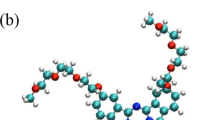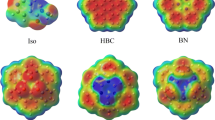Abstract
Reactions between the antibacterial fluoroquinolone agent ciprofloxacin (CIP) and organic hydrophilic nanoflakes (graphene oxide and boron nitride oxide) have been studied in aqueous medium using density functional theory (DFT), time-dependent density functional theory (TD-DFT), and molecular dynamics (MD) simulations. We found that CIP molecules in π-π electron donor–acceptor (EDA) reaction preserve their optical properties in water when adsorbed on hydrophilic nanoflakes. Moreover, MD calculations aimed at studying the diffusive translocation of CIP to lipid membrane showed that the choice of the hydrophilic nanovectors is primordial to stabilize the molecule on the cellular membrane and improve cytotoxic effects.








Similar content being viewed by others
Data availability
The raw/processed data required to reproduce these findings cannot be shared at this time due to technical or time limitations.
References
Riehemann K, Schneider SW, Luger TA, Godin B, Ferrari M, Fuchs H (2009) Nanomedicine—challenge and perspectives. Angew Chem 48:872–897
Friberg S, Nyström AM (2016) NANOMEDICINE: will it offer possibilities to overcome multiple drug resistance in cancer? J Nanobiotechnol 14:1–17
Zielińska-Górska MK, Sawosz E, Górski K, Chwalibog A (2017) Does nanobiotechnology create new tools to combat microorganisms? Nanotechnol Rev 6:171–189
Urbán P, Fernàndez-Busquets X (2014) Nanomedicine against malaria. Curr Med Chem 21:605–629
Hemeg HA (2017) Nanomaterials for alternative antibacterial therapy. Int J Nanomedicine 12:8211–8225
Durgalakshmi D, Balakumar S (2015) Phase separation induced shell thickness variations in electrospun hollow Bioglass 45S5 fiber mats for drug delivery applications. Phys Chem Chem Phys 17:15316–15323
Chen H, Zhang W, Zhu G, Xie J, Chen X (2017) Rethinking cancer nanotheranostics. Nat Rev Mater 2:17024
Baptista PV, McCusker MP, Carvalho A, Ferreira DA, Mohan NM, Martins M et al (2018) Nano-strategies to fight multidrug resistant bacteria—“a battle of the titans”. Front Microbiol 9:1441
LaVan DA, McGuire T, Langer R (2003) Small-scale systems for in vivo drug delivery. Nat Biotechnol 21:1184–1191
Shi J, Kantoff PW, Wooster R, Farokhzad OC (2017) Cancer nanomedicine: progress, challenges and opportunities. Nat Rev Cancer 17:20–37
Khalifi ME, Bentin J, Duverger E, Gharbi T, Boulahdour H, Picaud F (2016) Encapsulation capacity and natural payload delivery of an anticancer drug from boron nitride nanotube. Phys Chem Chem Phys 18:24994–25001
Duverger E, Bentin J, Delabrousse E, Gharbi T, Picaud F (2017) Ab initio study of azomethine derivative cancer drug on boron nitride and graphene nanoflakes. J Nanotechnol Nanomed Nanobiotechnol 4:1–6
Duverger E, Balme S, Bechelany M, Miele P, Picaud F (2019) Natural payload delivery of the doxorubicin anticancer drug from boron nitride oxide nanosheets. Appl Surf Sci 475:666–675
Fernandez-Moure JS, Evangelopoulos M, Colvill K, Eps JLV, Tasciotti E (2017) Nanoantibiotics: a new paradigm for the treatment of surgical infection. Nanomedecine 12:1319–1334
Weng Q, Wang B, Wang X, Hanagata N, Li X, Liu D et al (2014) Highly water-soluble, porous, and biocompatible boron nitrides for anticancer drug delivery. ACSnano 8:6123–6130
Wolfson J, Hooper DC (1989) Fluoroquinolone antimicrobial agents. Clin Microbiol Rev 2:378–424
Fisher LM, Lawrence JM, Josty IC, Hopewell R, Margerrison EEC, Cullen ME (1989) Ciprofloxacin and the fluoroquinolones new concepts on the mechanism of action and resistance. Am J Med 87:S2–S8
Emmerson AM, Jones AM (2003) The quinolones: decades of development and use. J Antimicrob Chemother 51:13–20
Vázquez JL, Merino S, Domenech O, Berlanga M, Viñas M, Montero MT et al (2001) Determination of the partition coefficients of a homologous series of ciprofloxacin: influence of the n − 4 piperazinyl alkylation on the antimicrobial activity. Int J Pharm 220:53–62
Cramariuc O, Rog T, Javanainen M, Monticelli L, Polishchuk AV, Vattulainen I (2012) Mechanism for translocation of fluoroquinolones across lipid membranes. Biochim Biophys Acta Biomembr 1818:2563–2571
Bansal S, Tandon V (2011) Contribution of mutations in DNA gyrase and topoisomerase IV genes to ciprofloxacin resistance in Escherichia coli clinical isolates. Int J Antimicrob Agents 37:253–255
Batt AL, Bruce IB, Aga DS (2006) Evaluating the vulnerability of surface waters to antibiotic contamination from varying wastewater treatment plant discharges. Environ Pollut 142:295–302
Ma J, Yang M, Yu F, Zheng J (2015) Water-enhanced removal of ciprofloxacin from water by porous graphene hydrogel. Sci Rep 5:13578 1–10
Singla P, Goel N, Singhal S (2016) Affinity of boron nitride nanomaterials towards antibiotics established by exhaustive experimental and theoretical investigations. Chem Eng J 299:403–414
Liu D, Lei W, Qin S, Klika KD, Chen Y (2016) Superior adsorption of pharmaceutical molecules by highly porous BN nanosheets. Phys Chem Chem Phys 18:84–88
Hohenberg P, Kohn W (1964) Inhomogeneous electron gas. Phys Rev 136:864–871
Kohn W, Sham LJ (1965) Self-consistent equations including exchange and correlation effects. Phys Rev 140:1133–1138
Ordejon P, Artacho E, Soler JM (1996) Self-consistent order-N density-functional calculations for very large systems. Phys Rev B 53:10441–10444
Soler JM, Artacho E, Gale JD, García A, Junquera J, Ordejón P et al (2002) The SIESTA method for ab initio order-N materials simulation. J Phys Condens Matter 14:2745–2779
Perdew JP, Burke K, Ernzerhof M (1996) Generalized gradient approximation made simple. Phys Rev Lett 77:3865–3868
Sainsbury T, Satti A, May P, Wang Z, McGovern I, Gun’ko YK et al (2012) Oxygen radical functionalization of boron nitride nanosheets. J Am Chem Soc 134:18758–18771
Lee D, Lee B, Park KH, Ryu HJ, Jeon S, Hong SH (2015) Scalable exfoliation process for highly soluble boron nitride nanoplatelets by hydroxide assisted ball milling. Nano Lett 15:1238–1244
Lin Y, Williams TV, Connell JW (2010) Soluble, exfoliated hexagonal boron nitride nanosheets. J Phys Chem Lett 1:277–283
Bagri A, Mattevi C, Acik M, Chabal YJ, Chhowalla M, Shenoy VB (2010) Structural evolution during the reduction of chemically derived graphene oxide. Nat Chem 2:581–587
Fan X, Peng W, Li Y, Li X, Wang S, Zhang G et al (2008) Deoxygenation of exfoliated graphite oxide under alkaline conditions: a green route to graphene preparation. Adv Mater 20(4490):3
Yu F, Sun S, Han S, Zheng J, Ma J (2016) Adsorption removal of ciprofloxacin by multi-walled carbon nanotubes with different oxygen contents from aqueous solutions. Chem Eng J 285:588–595
Peng X, Hu F, Lam FL-Y, Wang Y, Liu Z, Dai H (2015) Adsorption behavior and mechanisms of ciprofloxacin from aqueous solution by ordered mesoporous carbon and bamboo-based carbon. J Colloid Interface Sci 460:349–360
Andrade X, Strubbe D, Giovannini UD, Larsen AH, Oliveira MJT, Alberdi-Rodriguez J et al (2015) Real-space grids and the octopus code as tools for the development of new simulation approaches for electronic systems. Phys Chem Chem Phys 17:31371–31396
Castro A, Appel H, Oliveira M, Rozzi CA, Andrade X, Lorenzen F et al (2006) Octopus: a tool for the application of time-dependent density functional theory. Phys Status Solidi B 243:2465–2488
Marques MAL, Castro A, Bertsch GF, Rubio A (2003) Octopus: a first-principles tool for excited Electron-ion dynamics. Comput Phys Commun 151:60–78
Bader RFW (1991) A quantum theory of molecular structure and its applications. Chem Rev 91:893–928
Henkelman G, Arnaldsson A, Jońsson H (2006) A fast and robust algorithm for Bader decomposition of charge density. Comput Mater Sci 36:354–360
Mayne CG, Saam J, Schulten K, Tajkhorshid E, Gumbart JC (2013) Rapid parameterization of small molecules using the force field toolkit. J Comput Chem 34:2757–2770
Jo S, Kim T, Iyer VG, Im W (2008) CHARMM-GUI: a web- based graphical user Interface for CHARMM. J Comput Chem 29:1859–1865
Best RB, Zhu X, Shim J, Lopes PEM, Mittal J, Feig M et al (2012) Optimization of the additive CHARMM all- atom protein force field targeting improved sampling of the backbone φ, ψ and side-chain χ1 and χ2 dihedral angles. J Chem Theory Comput 8:3257–3273
Tantis I, Bousiakou L, Karikas G-A, Lianos P (2014) Photocatalytic and photoelectrocatalytic degradation of the antibacterial agent ciprofloxacin. Photochem Photobiol Sci 14:603–607
Cazedey ECL, Salgado HRN (2012) Spectrophotometric determination of ciprofloxacin hydrochloride in ophthalmic solution. Adv Anal Chem 2:74–79
Dewitte B, Dewulf J, Demeestere K, Vyvere VVD, Wispelaere PD, Langenhove HV (2008) Ozonation of ciprofloxacin in water: HRMS identification of reaction products and pathways. Environ Sci Technol 42:4889–4895
Funding
This present work was financially supported by the University of Franche-Comté. Calculations were performed with the supercomputer regional facility Mesocenter of the University of Franche-Comté. This work was also performed using HPC resources from GENCI-IDRIS (Grant 2017-[ A0010810075]).
Author information
Authors and Affiliations
Corresponding author
Additional information
Publisher’s note
Springer Nature remains neutral with regard to jurisdictional claims in published maps and institutional affiliations.
Rights and permissions
About this article
Cite this article
Duverger, E., Picaud, F. Theoretical study of ciprofloxacin antibiotic trapping on graphene or boron nitride oxide nanoflakes. J Mol Model 26, 135 (2020). https://doi.org/10.1007/s00894-020-04410-8
Received:
Accepted:
Published:
DOI: https://doi.org/10.1007/s00894-020-04410-8




